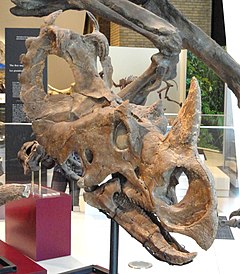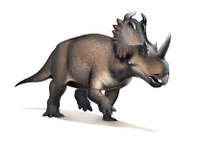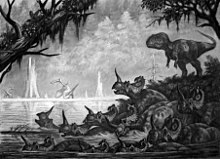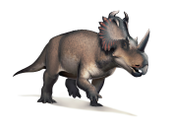尖角龍屬
| 尖角龙属 | |
|---|---|

| |
| 省立恐龙公园的颅骨标本ROM 767 | |
| 科学分类 | |
| 界: | 动物界 Animalia |
| 门: | 脊索动物门 Chordata |
| 纲: | 蜥形纲 Sauropsida |
| 总目: | 恐龍總目 Dinosauria |
| 目: | †鸟臀目 Ornithischia |
| 科: | †角龙科 Ceratopsidae |
| 亚科: | †尖角龍亞科 Centrosaurinae |
| 族: | †尖角龙族 Centrosaurini |
| 属: | †尖角龙属 Centrosaurus Lambe, 1904 |
| 模式種 | |
| †腔盾尖角龙 Centrosaurus apertus Lambe, 1904
| |
| 異名 | |
尖角龙屬(属名:Centrosaurus,发音:/ˌsɛntroʊˈsɔːrəs/ SEN-troh-SOR-əs)是植食性角龙科恐龙的一个属,生存于晚白垩世的加拿大,化石在恐龙公园组发现,地质年龄可追溯到7650至7550万年前。[1]
发现与命名
[编辑]
首批尖角龙遗骸由古生物学家劳伦斯·赖博(Lawrence Lambe)在加拿大阿尔伯塔省红鹿河流域地层中发现。属名意为“尖刺蜥蜴”,取自希腊语kentron/κέντρον(尖刺)及sauros/σαῦρος(蜥蜴),指沿颈盾边缘排列的小角而非鼻角(命名时鼻角尚未发现)。[2]其属名易与钉状龙混淆,两者来自相同的希腊文字源,但尖角龙字首改为“C”以避免混淆。
后来在同样位于阿尔伯塔省的恐龙省立公园发现大量尖角龙尸骨层,其中一些延伸数百米,含有数千具年龄及完整程度不同的个体。科学家推测,如果这些恐龙是在渡过泛洪河流时死亡,那么化石密度及数量为何如此之高就能得到解释。[3]阿尔伯塔省希尔达附近发现数千具尖角龙化石,据信是迄今为止最大的恐龙尸骨层,现被命名为希尔达大尸骨层。[4]
由于尖角龙物种甚至个体标本间的差异,关于哪些属种有效,尤其是尖角龙/独角龙是有效属、疑名还是两性异形的问题一直争议巨大。1996年,彼得·多德森(Peter Dodson)发现尖角龙、戟龙和独角龙之间有足够区别,可以划分为不同属,而且戟龙与尖角龙的相似性比两者任何一种与独角龙的相似性都要高。[5]

多德森认为独角龙物种之一的角鼻独角龙(Monoclonius nasicornus)实际上可能是雌性戟龙。[5]该结论得到部分支持,而一些研究者反对将角鼻种视为雌性戟龙,也不认为独角龙是有效属。[6]尽管目前已知基干角龙类原角龙存在两性异形,[7]但尚未发现来自任何角龙科的确凿证据。[8][9][10]其他人则认为角鼻独角龙是腔盾尖角龙(C. apertus)的异名[11]或尖角龙的一个种:角鼻尖角龙。[12]也有人视之为戟龙的直系祖先。[13]2014年,一项关于尖角龙生长变化的研究得出结论称角鼻种是腔盾种的次异名,代表该属的生长阶段中期。[14]
2005年描述的新种布氏尖角龙(C. brinkmani)于2012年建立新属冠饰角龙。[15]
描述
[编辑]
尖角龙的巨大躯干由强健的四肢支撑,尽管高达5.5米(18英尺),但并非特别大的恐龙。[16]和其它尖角龙亚科一样,尖角龙鼻部有一巨角,[3]该角前弯还是后弯取决于个体年龄。颅骨装饰随动物年龄增长而减少。[14]与颅骨总长相比,颈盾相对较短,在年龄最大的成体中可长到0.5米(1.6英尺)长。[14]
尖角龙拥有两只向前钩住颈盾的弯角,眼睛上方还有一对向上指的小角,颈盾长度中等,拥有相当大的窗和沿颈盾排列的小角。[3]
分类
[编辑]

尖角龙是命名尖角龙亚科(Centrosaurinae)的词源。其最近的近亲可能是戟龙和独角龙,且与后者非常相似,以至于一些古生物学家怀疑两者是同种动物。[3]尖角龙亚科演化支的其他成员包括厚鼻龙、[17][18]爱氏角龙、[17]野牛龙、[18][19]阿尔伯塔角龙[19]及河神龙。[18]
Chiba等人(2017年)系统发育分析的分支图如下所示:[20]
| 尖角龙亚科 Centrosaurinae |
| |||||||||||||||||||||||||||||||||||||||||||||||||||||||||||||||||||||||||||||||||||||||||||||||||||||||||||||||
古生物学
[编辑]
与其它角龙科一样,尖角龙下颚适合切割坚硬植物材料。加拿大发现的大片尖角龙尸骨层表明它们是群居动物,可以成群迁徙。[3]阿尔伯塔省的恐龙公园组也有一个由尖角龙和戟龙遗骸组成的尸骨层。[21]另一种可能是,尖角龙并非群居动物,这次大规模死亡是由干旱期间动物聚集在水坑周围造成。[22]发现尖角龙的地层比戟龙更深,表明前者随环境变化而被后者取代。[6]

角龙科的大型颈盾和鼻角是所有恐龙中最独特的面部装饰之一。自第一只有角恐龙发现以来,其功能一直是争论的话题,常见理论包括抵御捕食者、种内争斗和视觉展示。2009年,一项关于三角龙和尖角龙颅骨损伤的研究发现,颅骨上的损伤更可能是由种内战斗引起,而非由掠食者攻击所致。尽管三角龙厚且坚固的颈盾可能是为保护颈部而进化出来,但尖角龙颈盾太薄,无法抵御捕食者,因此最可能用于物种识别或其他形式的视觉展示。[23]
古病理学
[编辑]省立恐龙公园1989年出土的一具尖角龙标本,在其右腓骨中发现了严重的骨肉瘤,对骨内癌变情况的检查表明癌症已经达到晚期。癌症可以致残,使尖角龙更容易被捕食。然而,该个体实际上是兽群成员之一,使其存活时间比预期要长得多,据信是在山洪暴发时溺水身亡,而这场洪水也形成了发现该化石的尸骨层。该标本仍是少数患有严重癌症的恐龙标本之一。[24]
古生物地理学
[编辑]
托马斯·勒曼(Thomas M. Lehman)观察到,在阿尔伯塔省南部以外地区尚未发现尖角龙化石,尽管它们是该地区化石最丰富的朱迪斯阶恐龙之一。[25]大型植食动物如生活在晚白垩世北美的角龙科,尽管体型大、迁徙能力强,但分布区域却非常小。[25]这种有限分布与现代哺乳动物区系形成强烈对比,后者通常跨洲分布。[25]
参见
[编辑]参考资料
[编辑]- ^ Arbour, V.M., V. M.; Burns, M. E.; Sissons, R. L. A redescription of the ankylosaurid dinosaur Dyoplosaurus acutosquameus Parks, 1924 (Ornithischia: Ankylosauria) and a revision of the genus. Journal of Vertebrate Paleontology. 2009, 29 (4): 1117–1135. S2CID 85665879. doi:10.1671/039.029.0405.
- ^ Lambe, L. M. On the squamoso-parietal crest of the horned dinosaurs Centrosaurus apertus and Monoclonius canadensis from the Cretaceous of Alberta. Proceedings and Transactions of the Royal Society of Canada. 2. 1904, 10 (4): 1–9.
- ^ 3.0 3.1 3.2 3.3 3.4 "Centrosaurus." In: Dodson, Peter & Britt, Brooks & Carpenter, Kenneth & Forster, Catherine A. & Gillette, David D. & Norell, Mark A. & Olshevsky, George & Parrish, J. Michael & Weishampel, David B. The Age of Dinosaurs. Publications International, LTD. p. 135. ISBN 0-7853-0443-6.
- ^ Scientists find dino deathbed, signs of carnage. Edmonton Sun. http://www.edmontonsun.com/news/canada/2010/06/18/14439211.html 互联网档案馆的存檔,存档日期2010-06-22. 检索于2010-06-18
- ^ 5.0 5.1 Dodson, P. (1996). The Horned Dinosaurs: A Natural History. Princeton University Press: Princeton, New Jersey, pp. 197–199. ISBN 0-691-02882-6.
- ^ 6.0 6.1 Ryan, Michael J.; Evans, David C. Ornithischian Dinosaurs. Currie, Phillip J.; Koppelhus, Eva (编). Dinosaur Provincial Park: A Spectacular Ancient Ecosystem Revealed. Bloomington: Indiana University Press. 2005: 312–348. ISBN 0-253-34595-2.
- ^ Dodson, P. Quantitative aspects of relative growth and sexual dimorphism in Protoceratops. Journal of Paleontology: 929–940.
- ^ Forster, C. A. (1990). The cranial morphology and systematics of Triceratops, with a preliminary analysis of ceratopsian phylogeny. Ph.D. Dissertation. University of Pennsylvania, Philadelphia. 227 pp.
- ^ Lehman, T. M. A gigantic skull and skeleton of the horned dinosaur Pentaceratops sternbergi from New Mexico. Journal of Paleontology. 1998, 72 (5): 894–906. doi:10.1017/S0022336000027220.
- ^ Sampson, S. D.; Ryan, M.J.; Tanke, D.H. Craniofacial ontogeny in centrosaurine dinosaurs (Ornithischia: Ceratopsidae): taphonomic and behavioral phylogenetic implications. Zoological Journal of the Linnean Society. 1997, 121 (3): 293–337. doi:10.1111/j.1096-3642.1997.tb00340.x
 .
.
- ^ M.J. Ryan and D.C. Evans, 2005, "Ornithischian dinosaurs". In: P.J. Currie and E.B. Koppelhus (eds.), Dinosaur Provincial Park: A Spectacular Ancient Ecosystem Revealed. Indiana University Press, Bloomington pp 312-348
- ^ Russell, L.S. Upper Cretaceous dinosaur faunas of North America. Proceedings of the American Philosophical Society. 1930, 69 (4): 133–159.
- ^ Paul, G.S., 2010, The Princeton Field Guide to Dinosaurs, Princeton University Press p. 261
- ^ 14.0 14.1 14.2 Frederickson, J. A.; Tumarkin-Deratzian, A. R. Craniofacial ontogeny in Centrosaurus apertus. PeerJ. 2014, 2: e252. PMC 3933270
 . PMID 24688836. doi:10.7717/peerj.252.
. PMID 24688836. doi:10.7717/peerj.252.
- ^ Ryan, M. J.; Evans, D. C.; Shepherd, K. M.; Sues, H. A new ceratopsid from the Foremost Formation (middle Campanian) of Alberta. Canadian Journal of Earth Sciences. 2012, 49 (10): 1251. Bibcode:2012CaJES..49.1251R. doi:10.1139/e2012-056.
- ^ Paul, Gregory S. Princeton Field Guide to Dinosaurs
 . Princeton University Press. 2010. ISBN 978-0-691-13720-9.
. Princeton University Press. 2010. ISBN 978-0-691-13720-9.
- ^ 17.0 17.1 Dodson, P. On the status of the ceratopsids Monoclonius and Centrosaurus. Carpenter, K.; Currie, P.J. (编). Dinosaur Systematics: Perspectives and Approaches
 . Cambridge: Cambridge University Press. 1990: 231–243. ISBN 0-521-36672-0.
. Cambridge: Cambridge University Press. 1990: 231–243. ISBN 0-521-36672-0.
- ^ 18.0 18.1 18.2 Ryan, M.J.; A.P. Russell. A new centrosaurine ceratopsid from the Oldman Formation of Alberta and its implications for centrosaurine taxonomy and systematics. Canadian Journal of Earth Sciences. 2005, 42 (7): 1369–1387. Bibcode:2005CaJES..42.1369R. doi:10.1139/e05-029. hdl:1880/47001
 .
.
- ^ 19.0 19.1 Ryan, M.J. A new basal centrosaurine ceratopsid from the Oldman Formation, southeastern Alberta. Journal of Paleontology. 2007, 81 (2): 376–396. doi:10.1666/0022-3360(2007)81[376:ANBCCF]2.0.CO;2.
- ^ Kentaro Chiba; Michael J. Ryan; Federico Fanti; Mark A. Loewen; David C. Evans. New material and systematic re-evaluation of Medusaceratops lokii (Dinosauria, Ceratopsidae) from the Judith River Formation (Campanian, Montana). Journal of Paleontology. 2018,. in press (2): 272–288. S2CID 134031275. doi:10.1017/jpa.2017.62.
- ^ Eberth, David A.; Getty, Michael A. Ceratopsian bonebeds: occurrence, origins, and significance. Currie, Phillip J.; Koppelhus, Eva (编). Dinosaur Provincial Park: A Spectacular Ancient Ecosystem Revealed. Bloomington: Indiana University Press. 2005: 501–536. ISBN 0-253-34595-2.
- ^ Rogers, R. R. Taphonomy of three dinosaur bone beds in the Upper Cretaceous Two Medicine Formation, northwestern Montana: Evidence for drought-related mortality. PALAIOS (SEPM Society for Sedimentary Geology). 1990, 5 (5): 394–41. Bibcode:1990Palai...5..394R. JSTOR 3514834. doi:10.2307/3514834.
- ^ Farke, A.A.; Wolff, E.D.S.; Tanke, D.H. Evidence of Combat in Triceratops. PLOS ONE. 2009, 4 (1): e4252. Bibcode:2009PLoSO...4.4252F. PMC 2617760
 . PMID 19172995. doi:10.1371/journal.pone.0004252
. PMID 19172995. doi:10.1371/journal.pone.0004252  .
.
- ^ Ekhtiari, S.; Chiba, K.; Popovic, S.; Crowther, R.; Wohl, G.; Wong, A. K. O.; Tanke, D. H.; Dufault, D. M.; Geen, O. D.; Parasu, N.; Crowther, M. A.; Evans, D. C. First case of osteosarcoma in a dinosaur: a multimodal diagnosis. The Lancet Oncology. 2020, 21 (8): 1021−1022. PMID 32758461. S2CID 225473251. doi:10.1016/S1470-2045(20)30171-6.
- ^ 25.0 25.1 25.2 Lehman, T. M., 2001, Late Cretaceous dinosaur provinciality: In: Mesozoic Vertebrate Life, edited by Tanke, D. H., and Carpenter, K., Indiana University Press, pp. 310-328.




